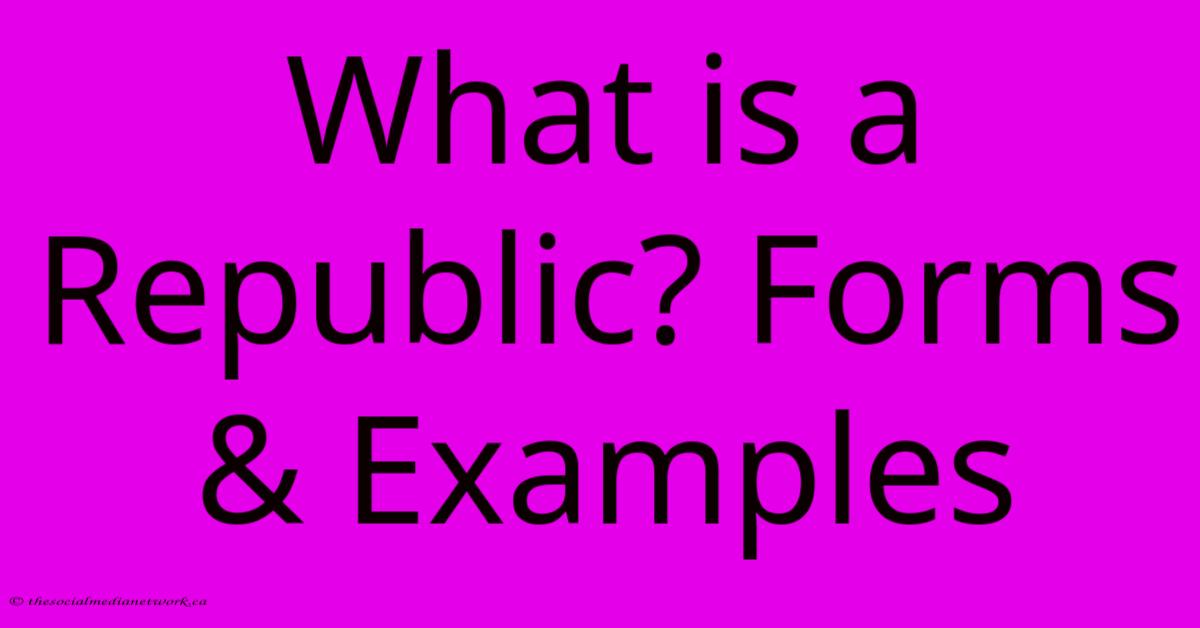What Is A Republic? Forms & Examples

Discover more detailed and exciting information on our website. Click the link below to start your adventure: Visit Best Website meltwatermedia.ca. Don't miss out!
Table of Contents
What is a Republic? Forms & Examples
Ever wondered about the difference between a kingdom and a republic? We often hear these terms thrown around, but understanding their nuances can be surprisingly insightful. This article dives deep into the concept of a republic, exploring its various forms and providing compelling real-world examples. Get ready to become a republic expert!
What Defines a Republic?
At its core, a republic is a form of government where supreme power is held by the people and their elected representatives, and which has an elected or nominated president rather than a monarch. This contrasts sharply with monarchies, where power is inherited through a royal family. The key element here is popular sovereignty: the idea that the ultimate authority rests with the citizens. This authority isn't directly exercised by the people themselves (as in a direct democracy), but rather through elected officials who are accountable to them.
Key Characteristics of a Republic:
- Representation: Citizens elect representatives to make decisions on their behalf.
- Rule of Law: Everyone, including those in power, is subject to the law.
- Separation of Powers: Power is typically divided among different branches of government (e.g., legislative, executive, judicial) to prevent tyranny.
- Limited Government: The government's power is restricted by a constitution or other legal framework.
- Citizen Participation: Citizens have the right to participate in the political process, typically through voting and other means.
Different Forms of Republics:
The term "republic" encompasses a wide variety of governmental structures. Here are some key variations:
Parliamentary Republic:
In a parliamentary republic, the head of state (often a president) is largely ceremonial, while the real political power resides with the parliament (legislature) and the prime minister, who is typically the leader of the majority party in parliament. Example: India. The President of India holds a largely ceremonial position, while the Prime Minister wields significant executive power.
Presidential Republic:
This is perhaps the most well-known type of republic. The president is both the head of state and head of government, holding considerable executive power. The president is usually elected separately from the legislature. Example: The United States. The US President is directly elected and holds significant executive power, distinct from the legislative branch (Congress).
Semi-Presidential Republic:
This system blends elements of both parliamentary and presidential republics. There's a president (often elected directly) and a prime minister (usually appointed by the president but accountable to the parliament). The balance of power between these two figures varies considerably depending on the specific country's constitution. Example: France. The French President has significant powers, but the Prime Minister manages the day-to-day operations of the government.
Real-World Examples of Republics:
- United States: A presidential republic with a strong emphasis on checks and balances.
- France: A semi-presidential republic with a powerful president and a prime minister responsible to the parliament.
- Germany: A parliamentary republic with a largely ceremonial president and a chancellor (prime minister) who leads the government.
- Brazil: A presidential republic with a directly elected president.
- India: A parliamentary republic with a ceremonial president and a powerful prime minister.
Challenges Faced by Republics:
Even the best-designed republics can face challenges. These might include:
- Corruption: Abuse of power and public funds.
- Inequality: Unequal distribution of wealth and resources.
- Political Polarization: Deep divisions within the political system.
- Weak Institutions: Ineffective or corrupt government institutions.
FAQ:
Q: What's the difference between a republic and a democracy? A: All republics are democracies (meaning power ultimately rests with the people), but not all democracies are republics. A direct democracy, for example, involves citizens directly making decisions, not through elected representatives.
Q: Can a republic be authoritarian? A: While the ideal republic emphasizes citizen participation and limits on government power, it's theoretically possible for a republic to become authoritarian. This happens when those in power manipulate the system to maintain control, even if they were initially elected.
Q: What are some of the advantages of a republic? A: Republics offer the potential for more stable government, protection against tyranny (through separation of powers), and greater citizen participation in governance.
In Conclusion:
The concept of a republic is multifaceted, encompassing a range of governmental systems. Understanding its diverse forms and challenges is crucial for navigating the complexities of global politics. Hopefully, this article has shed light on this fascinating and important topic.

Thank you for visiting our website wich cover about What Is A Republic? Forms & Examples. We hope the information provided has been useful to you. Feel free to contact us if you have any questions or need further assistance. See you next time and dont miss to bookmark.
Featured Posts
-
Republics Government By The People
Dec 04, 2024
-
Arsenal Manchester United 4 Dec 2024 Match Preview
Dec 04, 2024
-
Manhunt Launched Ceo Murdered Gunman Remains At Large
Dec 04, 2024
-
Digital Inks 2024 Market Forecast
Dec 04, 2024
-
Will Van Nistelrooy Keep Leicester Up
Dec 04, 2024
